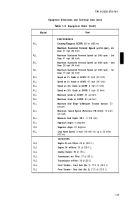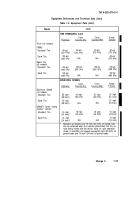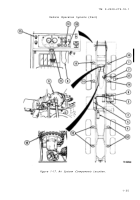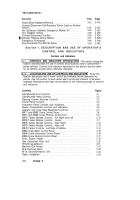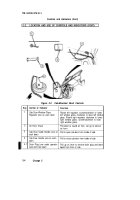TM-9-2320-279-10-1 - Page 53 of 773
TM 9-2320-279-10- 1
Vehicle Operation Systems (Cont)
1-15. AIR SYSTEM .
The air system (fig. 1-17) consists of an engine driven air
compressor (1) and four air reservoirs (2, 3, 4, and 5). Reservoir (4) is used on all
vehicles except the M983 tractor which has reservoir (6) instead.
The air system includes the necessary valves and air lines to control the
vehicle’s air operated parts. Pressurized air from the air compressor is passed
through the air dryer (7) to the quick buildup reservoir (2). The air dryer removes
dirt and moisture from the pressurized air. Air from reservoir goes to the throttle
treadle (8). Depending on how far the throttle treadle is depressed, 0 to 60 psi (0
to 414 kPa) is supplied to the engine throttle air cylinder (9) and to the
transmission modulator (10). This air pressure controls the vehicle speed.
Once air pressure in reservoir (2) rises above 75 psi (517 kPa), a valve opens
and allows reservoirs (3, 4 or 6, and 5) to be pressurized up to 120 psi (827 kPa).
Air from reservoir (4 or 6) goes to the brake treadle valve (11). This air controls
the rear axle service parking brakes (12). Air pressure in this system is shown by
the red needle on the AIR PRESS gage (13). Air from reservoir (3) goes to the
brake treadle valve. This air controls the front axle service brakes (14). Air
pressure in this system is shown by the green needle on the AIR PRESS gage.
The PARKING BRAKE valve (15) controls air from reservoirs (3 and 5) and
applies or releases the rear axle service (parking) brakes. Reservoirs (3, 4 or 6,
and 5) are interconnected so that if one reservoir fails, air is supplied to release
the rear axle service (parking) brakes from whichever reservoir is functioning. If
air pressure falls below 60 to 75 psi (414 kPa to 517 kPa), a buzzer will sound and
the AIR indicator (16) will light.
On the M984E1 the front brake actuator valve (17) is used to apply the front
axle service brakes when using heavy-duty winch.
1-3 4
Back to Top

